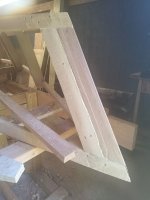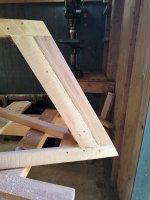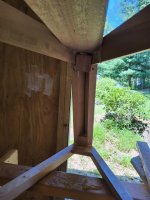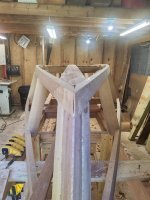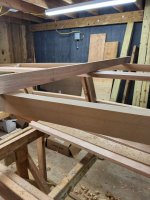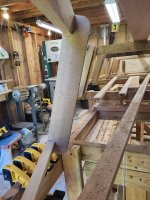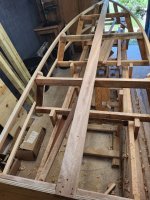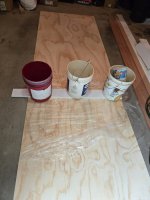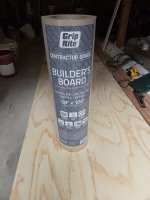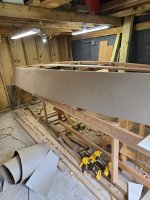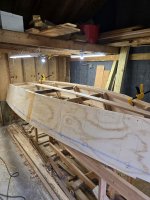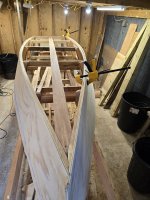Over the years, a few of us on the site have discussed rail hunting. The little birds comprising a half dozen species that live in our duck marshes, sometimes heard but rarely seen unless at the top of a flood tide or an actual flood in a river when they can't run. The traditional way to hunt them, going back into the 19th century is from a poled skiff, with a shooter seated amidships enjoying the day while the grunt poles from the stern. Rail hunting has been described as a "sport of kings", probably because the shooter enjoys a throne while his vassal poles him about. Friends and I have also walked them up in marshes where the bottom permits, in shorts and old sneakers because the birds are normally moving through in mid September to early November. As an old fart, walking them up is less attractive than poling, although both require serious effort.
There are as many rail skiffs as there are boatbuilders, the one common trait being near flat bottomed and narrow for ease of pushing through grass in a flooded marsh. The same skiffs might be used later in the season to pole creeks for ducks, or put to other important uses such as sight fishing striped bass in shallow bays.
I've built several rail skiffs, no two being the same. Because there aren't famous, classic designs like a BBSB, I feel free to employ artistic license in a build. I do however, appreciate the history of the sport, so when I decided to build one this year I took measurements off a boat in the care of a friend. Said friend is also a lurker on here on duckboats.net, who wisely perhaps, keeps himself out of the fray. This boat is a rail skiff built in about 1962 by a late waterman by the name of Oliver LaPlace. Oliver was quite famous along the lower Connecticut River, if you Google him a number or articles pop up along with at least one photo of him in this particular boat. In addition to poling sports for rail, he made a living guiding duck hunters, fishing and, famously, trapping snapping turtles for the market from the 1920's to the 80's.
A photo of Oliver's boat.
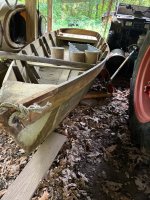
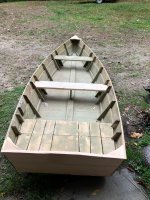
My technique for boat building is the old style chines and gunnels bent around molds mounted on a strongback. This boat is framed with Western Red Cedar and Phillipine Mahogany, to be sheathed in plywood and glassed on the exterior. The transom is 3/4 plywood, I couldn't get myself to spend more on this boat as the cedar and mahogany set me back almost a $1,000. The shed I'm building in is only 17' deep, so a 14' boat is a little tight as you can see in the photos. The waterline is 13'-3", LOA is 14'-2", depth inside 17". The photos are a progression, I set the molds up two weeks ago and installed the fairing strips to check the lines and then went on vacation. The build progress to date was completed since Saturday afternoon, so it's coming along quite quickly. I'm working fast because I also have home renovations to complete by the end of the summer, if I don't get that stuff done I'm in trouble. To move things along, I used Gorilla glue to fasten the frame, along with a healthy number of screws. The sheathing will be glued with epoxy, the same to be utilized for the glass.
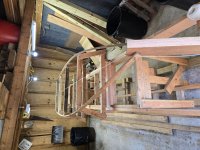
The first photo is just the molds and fairing strips, to check the lines.
In this series of photos, you can see that the lines deviate from the LaPlace skiff. I had to lengthen it about 6" because the wood wouldn't take any more bend without steaming. I think a pointy bow is a good thing in the grass.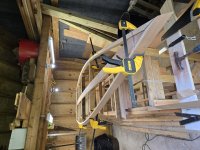
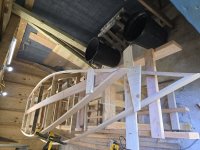
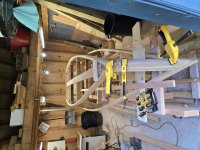
More photos to come today.
There are as many rail skiffs as there are boatbuilders, the one common trait being near flat bottomed and narrow for ease of pushing through grass in a flooded marsh. The same skiffs might be used later in the season to pole creeks for ducks, or put to other important uses such as sight fishing striped bass in shallow bays.
I've built several rail skiffs, no two being the same. Because there aren't famous, classic designs like a BBSB, I feel free to employ artistic license in a build. I do however, appreciate the history of the sport, so when I decided to build one this year I took measurements off a boat in the care of a friend. Said friend is also a lurker on here on duckboats.net, who wisely perhaps, keeps himself out of the fray. This boat is a rail skiff built in about 1962 by a late waterman by the name of Oliver LaPlace. Oliver was quite famous along the lower Connecticut River, if you Google him a number or articles pop up along with at least one photo of him in this particular boat. In addition to poling sports for rail, he made a living guiding duck hunters, fishing and, famously, trapping snapping turtles for the market from the 1920's to the 80's.
A photo of Oliver's boat.


My technique for boat building is the old style chines and gunnels bent around molds mounted on a strongback. This boat is framed with Western Red Cedar and Phillipine Mahogany, to be sheathed in plywood and glassed on the exterior. The transom is 3/4 plywood, I couldn't get myself to spend more on this boat as the cedar and mahogany set me back almost a $1,000. The shed I'm building in is only 17' deep, so a 14' boat is a little tight as you can see in the photos. The waterline is 13'-3", LOA is 14'-2", depth inside 17". The photos are a progression, I set the molds up two weeks ago and installed the fairing strips to check the lines and then went on vacation. The build progress to date was completed since Saturday afternoon, so it's coming along quite quickly. I'm working fast because I also have home renovations to complete by the end of the summer, if I don't get that stuff done I'm in trouble. To move things along, I used Gorilla glue to fasten the frame, along with a healthy number of screws. The sheathing will be glued with epoxy, the same to be utilized for the glass.

The first photo is just the molds and fairing strips, to check the lines.
In this series of photos, you can see that the lines deviate from the LaPlace skiff. I had to lengthen it about 6" because the wood wouldn't take any more bend without steaming. I think a pointy bow is a good thing in the grass.



More photos to come today.
Last edited:

